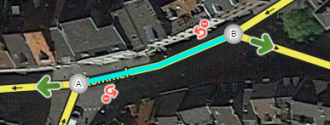U-turn

Two-way segments will also show the small U-turn arrow icon at both ends of the segment. This is used, as its name suggests, to prevent/enable Waze to use a segment end node as a U-turn, in case of necessity.
The standard rule in the Netherlands: U-turns should be disabled: ![]() .
.
Bedenk dat Waze gebruikt wordt in allerlei auto's, groot of klein, bestuurd door chauffeurs met uiteenlopende ervaring en talent, met of zonder aanhanger. Bedenk ook dat we nooit weten wat de verkeerssituatie is op het moment dat een Wazer ergens rijdt.
We zijn daarom extreem terughoudend met het toestaan van U-turns. En als we dat al doen dan alleen op plekken waar er voldoende ruimte is om een U-turn in één vloeiende beweging te maken. Vaak is dat alléén mogelijk als er een verbindingssegment van voldoende lengte tussen 2 wegen aanwezig is.
U-turns explained

A curved green arrow indicates that a u-turn is allowed in the manner and direction indicated by the arrow at that end of the segment.
![]() When you hover the mouse over an allowed u-turn arrow, a small clock icon appears, which, when clicked on, allowed you to set scheduled u-turn restrictions, as well as vehicle type restrictions on the U-turn.
When you hover the mouse over an allowed u-turn arrow, a small clock icon appears, which, when clicked on, allowed you to set scheduled u-turn restrictions, as well as vehicle type restrictions on the U-turn.
![]() A curved red arrow with the slashed-circle icon indicates that a u-turn is not allowed (is restricted) in the manner and direction indicated by the arrow at that end of the segment.
A curved red arrow with the slashed-circle icon indicates that a u-turn is not allowed (is restricted) in the manner and direction indicated by the arrow at that end of the segment.
![]() A curved yellow arrow with a clock icon indicates the presence of scheduled (time-based) turn restrictions for the direction indicated by the arrow at that end of the segment.
A curved yellow arrow with a clock icon indicates the presence of scheduled (time-based) turn restrictions for the direction indicated by the arrow at that end of the segment.
Remarks
- See for U-turn prevention the Road aspects page paragraph Double left and double right.